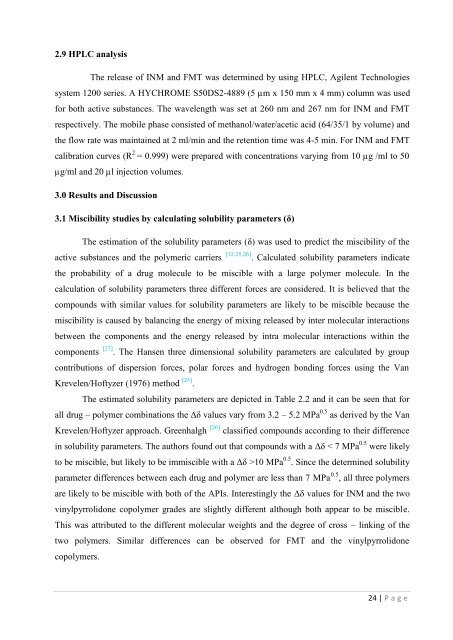Development of hot-melt extrusion as a novel technique for the ...
Development of hot-melt extrusion as a novel technique for the ...
Development of hot-melt extrusion as a novel technique for the ...
Create successful ePaper yourself
Turn your PDF publications into a flip-book with our unique Google optimized e-Paper software.
2.9 HPLC analysisThe rele<strong>as</strong>e <strong>of</strong> INM and FMT w<strong>as</strong> determined by using HPLC, Agilent Technologiessystem 1200 series. A HYCHROME S50DS2-4889 (5 µm x 150 mm x 4 mm) column w<strong>as</strong> used<strong>for</strong> both active substances. The wavelength w<strong>as</strong> set at 260 nm and 267 nm <strong>for</strong> INM and FMTrespectively. The mobile ph<strong>as</strong>e consisted <strong>of</strong> methanol/water/acetic acid (64/35/1 by volume) and<strong>the</strong> flow rate w<strong>as</strong> maintained at 2 ml/min and <strong>the</strong> retention time w<strong>as</strong> 4-5 min. For INM and FMTcalibration curves (R 2 = 0.999) were prepared with concentrations varying from 10 µg /ml to 50µg/ml and 20 µl injection volumes.3.0 Results and Discussion3.1 Miscibility studies by calculating solubility parameters ()The estimation <strong>of</strong> <strong>the</strong> solubility parameters () w<strong>as</strong> used to predict <strong>the</strong> miscibility <strong>of</strong> <strong>the</strong>active substances and <strong>the</strong> polymeric carriers [12,25,26] . Calculated solubility parameters indicate<strong>the</strong> probability <strong>of</strong> a drug molecule to be miscible with a large polymer molecule. In <strong>the</strong>calculation <strong>of</strong> solubility parameters three different <strong>for</strong>ces are considered. It is believed that <strong>the</strong>compounds with similar values <strong>for</strong> solubility parameters are likely to be miscible because <strong>the</strong>miscibility is caused by balancing <strong>the</strong> energy <strong>of</strong> mixing rele<strong>as</strong>ed by inter molecular interactionsbetween <strong>the</strong> components and <strong>the</strong> energy rele<strong>as</strong>ed by intra molecular interactions within <strong>the</strong>components [27] . The Hansen three dimensional solubility parameters are calculated by groupcontributions <strong>of</strong> dispersion <strong>for</strong>ces, polar <strong>for</strong>ces and hydrogen bonding <strong>for</strong>ces using <strong>the</strong> VanKrevelen/H<strong>of</strong>tyzer (1976) method [25] .The estimated solubility parameters are depicted in Table 2.2 and it can be seen that <strong>for</strong>all drug – polymer combinations <strong>the</strong> values vary from 3.2 – 5.2 MPa 0.5 <strong>as</strong> derived by <strong>the</strong> VanKrevelen/H<strong>of</strong>tyzer approach. Greenhalgh [26] cl<strong>as</strong>sified compounds according to <strong>the</strong>ir differencein solubility parameters. The authors found out that compounds with a < 7 MPa 0.5 were likelyto be miscible, but likely to be immiscible with a >10 MPa 0.5 . Since <strong>the</strong> determined solubilityparameter differences between each drug and polymer are less than 7 MPa 0.5 , all three polymersare likely to be miscible with both <strong>of</strong> <strong>the</strong> APIs. Interestingly <strong>the</strong> values <strong>for</strong> INM and <strong>the</strong> twovinylpyrrolidone copolymer grades are slightly different although both appear to be miscible.This w<strong>as</strong> attributed to <strong>the</strong> different molecular weights and <strong>the</strong> degree <strong>of</strong> cross – linking <strong>of</strong> <strong>the</strong>two polymers. Similar differences can be observed <strong>for</strong> FMT and <strong>the</strong> vinylpyrrolidonecopolymers.24 | P a g e
















